Henry Cloud's Blog, page 22
June 15, 2015
Love Only Exists Where There is Freedom
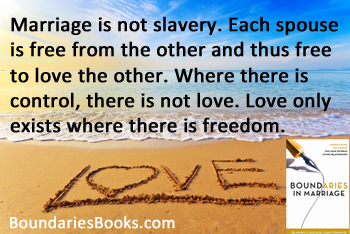 “His irresponsibility is making my life miserable,” Jen began. She then went on to tell me (Dr. Townsend) a terrible story of how her husband had successfully avoided adulthood for many years at her expense. She had suffered greatly at the hands of his behavior, both financially and sexually.
“His irresponsibility is making my life miserable,” Jen began. She then went on to tell me (Dr. Townsend) a terrible story of how her husband had successfully avoided adulthood for many years at her expense. She had suffered greatly at the hands of his behavior, both financially and sexually.
As I listened, though, I could see that her deep sense of hopelessness kept her in prison. I could see countless ways she could be free from her husband’s patterns of behavior. She could make numerous choices to help both herself and the relationship. But the sad thing was that she could not see the same choices that were so clear to me.
“Why don’t you stop paying for his mistakes and bailing him out? Why do you keep rescuing him from the messes he gets himself into?” I asked.
“What are you talking about?” Jen asked, alternating between muffled sobs and a scornful expression. “There’s nothing I can do. This is the way he is, and I just have to live with it.”
I could not tell if she was sad about what she perceived as a hopeless case or angry with me for suggesting she had choices. As we talked further, I discovered an underlying problem that kept Jen from making such choices.
She did not experience herself as a free agent. It never occurred to her that she had the freedom to respond, to make choices, to limit the ways his behavior affected her. She felt that she was a victim of whatever he did or did not do.
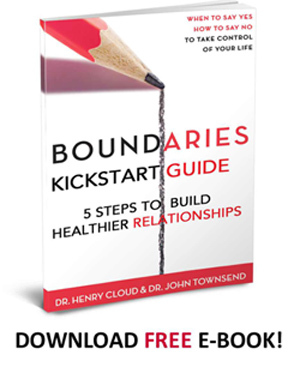
Click here to download FREE 17-page e-Book
God designed the entire creation for freedom. We were not meant to be enslaved by each other; we were meant to love each other freely. God designed us to have freedom of choice as we responded to life, to other people, to God, and to ourselves. But when we turned from God, we lost our freedom. We became enslaved to sin, to self-centeredness, to other people, to guilt, and to a whole host of other dynamics. She did not experience herself as a free agent. It never occurred to her that she had the freedom to respond, to make choices, to limit the ways his behavior affected her.
Boundaries help us to realize our freedom once again. Listen to the way that Paul tells the Galatians to set boundaries against any type of control and become free: “It was for freedom that Christ set us free; therefore keep standing firm and do not be subject again to a yoke of slavery” (see Galatians 5:1). Jen felt herself enslaved by her husband’s patterns of behavior and did not see the choices available to her. But God tells us to not be subject to any kind of enslaving control at all.
For love to work, each spouse has to realize his or her freedom. And boundaries help define the freedom we have and the freedom we do not have. Marriage is not slavery. It is based on a love relationship deeply rooted in freedom. Each partner is free from the other and therefore free to love the other. Where there is control, or perception of control, there is not love. Love only exists where there is freedom.
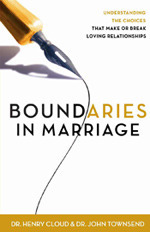 For more helpful advice to enhance your marriage, read the award-winning book, Boundaries in Marriage, by Drs. Henry Cloud and John Townsend.
For more helpful advice to enhance your marriage, read the award-winning book, Boundaries in Marriage, by Drs. Henry Cloud and John Townsend.
Beach image courtesy of Noppasinw at FreeDigitalPhotos.net
The post Love Only Exists Where There is Freedom appeared first on Boundaries Books.
June 11, 2015
Is Your Leadership Ridiculously In Charge?
 Recently I (Dr. Cloud) was discussing personnel issues with a CEO. I asked him why he thought those problems were there. He talked about some reasons, most of which had to do with the various players involved, and also the constellations of a few teams. But then I asked him a simple question. “And why is that?” I asked.
Recently I (Dr. Cloud) was discussing personnel issues with a CEO. I asked him why he thought those problems were there. He talked about some reasons, most of which had to do with the various players involved, and also the constellations of a few teams. But then I asked him a simple question. “And why is that?” I asked.
“What do you mean? I think it is the reasons I just said.”
“I know the reasons you said, but why do those reasons exist?” I continued.
“I don’t get it. What do you mean?” he asked further.
“Who is the leader? Who is in charge of the culture? Who is in charge of the ways that it is working, the fact that all of that exists?” I pushed.
He just looked at me, and nodded. “I am,” he said.
“So what kind of culture would you like?” I asked. “What kind of culture would drive the business forward if you had it?”
 When he thought about that, he looked upward, lost in thought for a moment. Then he got out of the “problem-speak” mode, and I could see a shift in his energy as a new vision of a different culture sprang to life in his eyes. He began to describe a company culture that was positive, highly energetic, accountable, innovative, and performance oriented. He came alive when he talked about it. “So why don’t you build that kind of culture?” I asked.
When he thought about that, he looked upward, lost in thought for a moment. Then he got out of the “problem-speak” mode, and I could see a shift in his energy as a new vision of a different culture sprang to life in his eyes. He began to describe a company culture that was positive, highly energetic, accountable, innovative, and performance oriented. He came alive when he talked about it. “So why don’t you build that kind of culture?” I asked.
For a nanosecond it seemed like he was about to reflexively blurt out a reason why it could not happen, but then he paused and said something I will never forget: “You know, when you think about it…I am ridiculously in charge.”
At that point, I knew he got it. He realized that he would have exactly the culture that he creates and would not have the one he did not allow to exist. Whatever culture he got, he was either building it or allowing it. He was “ridiculously in charge,” that is, “totally in charge,” and at that moment, he owned it. It was his. It was truly up to him. As a leader, he was going to get what he built, or what he allowed.
In your leadership at work or at home, are you building the environment you want or just allowing things to happen? What change could you initiate to be ridiculously in charge?
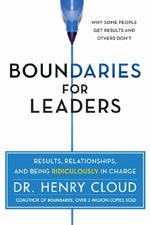 For more insights to improve your leadership skills, read Boundaries for Leaders.
For more insights to improve your leadership skills, read Boundaries for Leaders.
Landscape image courtesy of Worakit Sirijinda at FreeDigitalPhotos.net
The post Is Your Leadership Ridiculously In Charge? appeared first on Boundaries Books.
June 7, 2015
Love Is As Love Does
 George sat in my (Dr. Cloud’s) office, despondent. His wife, Janet, whom he loved deeply, had just moved out because he had lost another job. A very talented person, George seemed to have everything he needed for success. But he had lost several good jobs because of his irresponsibility and inability to follow through. Bosses loved the talent but hated the performance. And after several family disruptions because of his failures, Janet had had enough.
George sat in my (Dr. Cloud’s) office, despondent. His wife, Janet, whom he loved deeply, had just moved out because he had lost another job. A very talented person, George seemed to have everything he needed for success. But he had lost several good jobs because of his irresponsibility and inability to follow through. Bosses loved the talent but hated the performance. And after several family disruptions because of his failures, Janet had had enough.
“I love her so much,” George said to me. “Doesn’t she see that?”
“I believe that you love her,” I said. “But in reality, I don’t think that she does see your love. All she sees is the effect your behavior has had on her and the children, and she asks herself, ‘How can he love us and treat us this way?’ You cannot just love someone and not deliver. Love without the fruits of love is really not love in the end. She feels very unloved because of what you have put her through.”
If George was to have a chance of winning Janet back, it would not come through one more empty promise. He needed to develop boundaries to gain the self-control that would make him a responsible person. Janet was only going to believe in action, not just talk about love.
George had never been required to deliver the fruits of love when growing up. His parents were fine, hardworking people. But having gone through the Depression and a lifetime of hard work, they did not want George to have to struggle as they had. As a result, they indulged him and required very little work from him.
When they did give him chores and responsibilities and he did not deliver, they would not discipline him, thinking that they wanted him to have “positive self-esteem” rather than the “guilt” with which they grew up. Consequently, he did not see any negative effect on his loved ones when he did not perform.
But marriage was different. He was now in a relationship in which the one he loved also had requirements for him, and things were falling apart. For George to become a truly loving person, one whose love actually made a difference in the lives of others, he was going to have to become a responsible person. In the end, love is as love does.
Loving people respect the boundaries of others. Have you ever been in a relationship with a person who could not hear the word no? How did you feel? Typically one feels controlled, manipulated, and resentful instead of respected and loved. A controlling person steps over the line and tries to possess the other. This does not feel very loving, no matter how much the offender says he cares.
Loving people are able to control their impulses. Many alcoholics, for example, have great love for their families. Their drinking greatly troubles them, and they feel horrendous guilt. But still they drink, and although, like George, they love, the effects of their lack of ability to say no to alcohol ends up destroying the relationships they care about. Many other impulse problems—such as sexual acting out, overspending, food or drug abuse, and rage attacks—end up destroying love as well. A lack of boundaries keeps these behaviors going.
 Ready to go deeper on this topic? Discover how to set healthy limits in any situation and prevent unnecessary burdens from controlling your peace and energy in the award-winning book, Boundaries.
Ready to go deeper on this topic? Discover how to set healthy limits in any situation and prevent unnecessary burdens from controlling your peace and energy in the award-winning book, Boundaries.
The post Love Is As Love Does appeared first on Boundaries Books.
June 4, 2015
Two Kinds of Boundaries
 To see how setting limits plays out in relationships, it’s important to understand that there are two types of boundaries – defining boundaries and protective boundaries. Each kind of boundary has a distinct purpose. It’s important that you learn the difference, because defining should become permanent in your life, while protective boundaries are the ones you can move “beyond.”
To see how setting limits plays out in relationships, it’s important to understand that there are two types of boundaries – defining boundaries and protective boundaries. Each kind of boundary has a distinct purpose. It’s important that you learn the difference, because defining should become permanent in your life, while protective boundaries are the ones you can move “beyond.”
Defining boundaries are values that establish who you are and who you are not. They are at the core of your identity and reflect what you believe is important and valuable in life. Here are a few examples:
I follow God and his ways and will always live my life in him.
I love my family and friends, and I will treat them with grace and truth.
I know my mission and purpose in life, and I will not divert from it.
I say and receive the truth; I’m neither silent in saying it nor defensive in receiving it.
These defining boundaries help you and others know the real you, the person who has substance and stands for things that matter. They help guide your decisions and directions in life. Here are some examples of how defining boundaries might be used in your relationships:
“I’m looking for a position that fits my strategic abilities rather than one that is in operations.”
“We have a rule that all who live in this house go to church.”
“I want to hear the truth from you about how you think we are doing in our relationship.”
“I’m a night owl, so let’s not plan something that requires that we get up at, oh, dark thirty.”
This is simply how you tell people who you are and how they tell you who they are. You clarify and define yourselves with these sorts of boundaries.
Protective boundaries are different. They are designed to “guard your heart” (see Proverbs 4:23), and your life, from danger or trouble. There are times when you must protect your values, emotions, gifts, time, and energy from people and situations that may waste or injure them. Protective boundaries have several elements to them. You have to face the reality that talking hasn’t fixed a situation, and you have to set a limit.
A protective boundary might begin with a statement like this: “I want us to work this out, but nothing I’ve said has made any difference, so I’m taking a different route.” This affirms that you value the relationship and that you want the other person to understand that your actions are not punitive but, ultimately, redemptive. You are simply trying to solve a difficulty in the relationship with your protective boundaries.
The consequences portion of the boundary then needs to be stated in an “If . . . then . . .” form to make sure the other person understands you mean business. For example, consider the following statements:
“If you continue being thirty minutes late to events, I will take a separate car.”
”I need a better work ethic from you in the office, or we’ll have to make some changes.”
“If you keep spending over our budget, I will cut up the credit cards.”
“I can’t lend you any more money until I see you making serious efforts to find a job.”
“I want to bring your grandkids to see you, but if you just surf the Web while we’re there, it’s not worth it to come.”
“I want to see my grandkids at times when you don’t need a babysitter; otherwise I feel taken advantage of.”
“If you won’t stop drinking too much or using drugs, I will take the kids and move out.”
Here’s the important distinction between a defining boundary and a protective boundary. A defining boundary is forever and unchangeable, part of what makes you “you”; a protective boundary can change if the other person responds to it in a healthy way. Your defining boundaries mean that, for example, you will always follow God, love people, be committed to personal and spiritual growth, and so forth.
These are the core parts of you, and you don’t change them. But you might change a protective boundary if the other person understands what they are doing to you and makes a significant change. Then you might lessen or end the consequence: no separate cars, no making changes, reissue the credit cards, and so forth. When the change happens, you no longer need the protection.
 Ready to go deeper on this topic? Discover how to set healthy limits in any situation and prevent unnecessary burdens from controlling your peace and energy in the New York Times bestselling book, Boundaries.
Ready to go deeper on this topic? Discover how to set healthy limits in any situation and prevent unnecessary burdens from controlling your peace and energy in the New York Times bestselling book, Boundaries.
–
The post Two Kinds of Boundaries appeared first on Boundaries Books.
June 1, 2015
Boundaries Back At You – How to Set Limits on Yourself
 Sarah had been working on major boundaries issues in her therapy for a while now. She was seeing progress in resolving responsibility conflicts with her parents, her husband, and her kids. Yet today she introduced a new issue.
Sarah had been working on major boundaries issues in her therapy for a while now. She was seeing progress in resolving responsibility conflicts with her parents, her husband, and her kids. Yet today she introduced a new issue.
“I haven’t told you about this relationship before, though I guess I should have. I have tremendous boundary problems with this woman. She eats too much, and has an attacking tongue. She’s undependable — lets me down all the time. And she’s spent money of mine and hasn’t paid me back in years.”
“Why haven’t you mentioned her before?” I asked.
“Because she’s me,” Sarah replied.
Sarah was echoing the conflict most of us have. We learn that boundaries are biblical. We begin setting limits on others. We begin moving from taking too much responsibility to taking just enough. But how do we begin to set limits on ourselves?
Instead of looking at the control and manipulation of others, we also need to be looking at our responsibility to control our internal boundary conflicts. This can get a little touchy. But, instead of a defensive posture, we are much better off to look humbly at ourselves. To ask for feedback from others. To listen to people we trust. And to confess, “I was wrong.”
Since the Fall, our instincts have been to withdraw from relationship when we’re in trouble, when we most need other people. (Remember how Adam and Eve hid from God after they ate the forbidden fruit?) Due to our lack of security, our loss of grace, our shame, and our pride, we turn inward, rather than outward, when we’re in trouble. And that’s a problem. As Ecclesiastes 4:10 puts it, “Woe to one who is alone and falls and does not have another to help.”
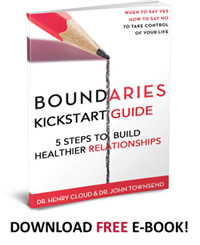 Such withdrawal happens in our program time after time. For the first time, hurting people come forth with their need for connection. Like a rose lifting its petals after a hard rain, they begin to relate and connect in the light of the grace of God and his people. Then an unexpected setback will occur. Instead of bringing the painful and frightening feelings and problems to their newfound relationships, these people will often retreat to work out the problem alone.
Such withdrawal happens in our program time after time. For the first time, hurting people come forth with their need for connection. Like a rose lifting its petals after a hard rain, they begin to relate and connect in the light of the grace of God and his people. Then an unexpected setback will occur. Instead of bringing the painful and frightening feelings and problems to their newfound relationships, these people will often retreat to work out the problem alone.
It is only when this attempt at a solution breaks down that they finally realize that these spiritual pains and burdens need to be brought out of themselves to the body of Christ. Truly every person needs to feel very secure before she will risk taking her spiritual and emotional problems to other people.
And yet the Bible doesn’t recognize any other answer to our problems. Grace must come from the outside of ourselves to be useful and healing. Just as the branch withers without the vine, we can sustain neither life nor emotional repair without bonding to God and others. God and his people are the fuel, the energy source from which any problem is addressed.
Whether our boundaries issue is food, substances, sex, time, projects, the tongue, or money, we can’t solve it in a vacuum. If we could, we would. But the more we isolate ourselves, the harder our struggle becomes. Just like an untreated cancer can become life-threatening in a short time, self-boundary problems will worsen with increased aloneness. We need to the body of Christ to heal and to grow up.
 Ready to go deeper on this topic? Discover how to set healthy limits in any situation and prevent unnecessary burdens from controlling your peace and energy in the award-winning book, Boundaries.
Ready to go deeper on this topic? Discover how to set healthy limits in any situation and prevent unnecessary burdens from controlling your peace and energy in the award-winning book, Boundaries.
Image courtesy of adamr at FreeDigitalPhotos.net
The post Boundaries Back At You – How to Set Limits on Yourself appeared first on Boundaries Books.
May 28, 2015
What Does a Boundary Look Like?
 The parents of a twenty-five-year-old man came to see me (Dr. Townsend) with a common request: they wanted me to “fix” their son, Bill.
The parents of a twenty-five-year-old man came to see me (Dr. Townsend) with a common request: they wanted me to “fix” their son, Bill.
When I asked where Bill was, they answered, “Oh, he didn’t want to come.”
“Why?” I asked.
“Well, he doesn’t think he has a problem,” they replied.
“Maybe he’s right,” I said, to their surprise. “Tell me about it.”
They recited a history of problems that had begun at a very young age. Bill had never been “quite up to snuff” in their eyes. In recent years he had exhibited problems with drugs and an inability to stay in school and find a career.
It was apparent that they loved their son very much and were heartbroken over the way he was living. They had tried everything they knew to get him to change and live a responsible life, but all had failed. He was still using drugs, avoiding responsibility, and keeping questionable company.
They told me that they had always given him everything he needed. He had plenty of money at school so “he wouldn’t have to work and he would have plenty of time for study and a social life.” When he flunked out of one school, or stopped going to classes, they were more than happy to do everything they could to get him into another school, “where it might be better for him.”
After they had talked for a while, I responded: “I think your son is right. He doesn’t have a problem.” You could have mistaken their expression for a snapshot; they stared at me in disbelief for a full minute. Finally the father said, “Did I hear you right? You don’t think he has a problem?”
“That’s correct,” I said. “He doesn’t have a problem. You do. He can do pretty much whatever he wants, no problem. You pay, you fret, you worry, you plan, you exert energy to keep him going. He doesn’t have a problem because you have taken it from him. Those things should be his problem, but as it now stands, they are yours. Would you like for me to help you help him to have some problems?” They looked at me like I was crazy, but some lights were beginning to go on in their heads.
“What do you mean, ‘help him to have some problems’?” his mother asked.
“Well,” I explained, “I think that the solution to this problem would be to clarify some boundaries so that his actions cause him problems and not you.”
“What do you mean, ‘boundaries’?” the father asked.
“Look at it this way. It is as if he’s your neighbor, who never waters his lawn. But, whenever you turn on your sprinkler system, the water falls on his lawn. Your grass is turning brown and dying, but Bill looks down at his green grass and thinks to himself, ‘My yard is doing fine.’ That is how your son’s life is. He doesn’t study, or plan, or work, yet he has a nice place to live, plenty of money, and all the rights of a family member who is doing his part.
“If you would define the property lines a little better, if you would fix the sprinkler system so that the water would fall on your lawn, and if he didn’t water his own lawn, he would have to live in dirt. He might not like that after a while. As it stands now, he is irresponsible and happy, and you are responsible and miserable. A little boundary clarification would do the trick. You need some fences to keep his problems out of your yard and in his, where they belong.”
“Isn’t that a bit cruel, just to stop helping like that?” the father asked.
“Has helping him helped?” I asked.
His look told me that he was beginning to understand.
The post What Does a Boundary Look Like? appeared first on Boundaries Books.
May 25, 2015
Raising Kids With an Eye on the Future
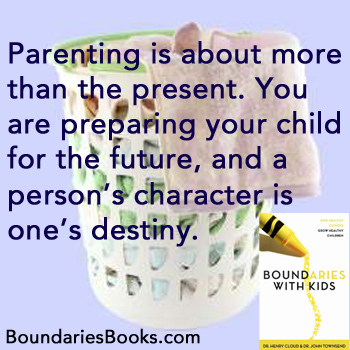 It was a normal day, but one that would forever change my friend’s parenting. We had finished dinner, and I (Dr. Cloud) was visiting with my friend, Allison, and her husband, Bruce, when she left the dinner table to do some chores. Bruce and I continued to talk until a phone call took him away as well, so I went to see if I could lend Allison a hand.
It was a normal day, but one that would forever change my friend’s parenting. We had finished dinner, and I (Dr. Cloud) was visiting with my friend, Allison, and her husband, Bruce, when she left the dinner table to do some chores. Bruce and I continued to talk until a phone call took him away as well, so I went to see if I could lend Allison a hand.
I could hear her in their 14-year-old son Cameron’s room. I walked in to a scene that jolted me. She was cheerfully putting away clothes and sports equipment and making the bed. She struck up a conversation as if things were normal: “I can’t wait for you to see the pictures from our trip. It was so much—” “What are you doing?” I asked. “I’m cleaning up Cameron’s room,” she said. “What does it look like I’m doing?” “You are what?” “I told you. I’m cleaning up his room. Why are you looking at me like that?” All I could do was to share with her the vision in my head. “I just feel sorry for Cameron’s future wife.”
Allison straightened up, froze for a moment, and then hurried from the room. I walked into the hall to see her standing there motionless. Not knowing what to say, I said nothing. After a few moments, she looked at me and said, “I’ve never thought about it that way.”
Nor have most of us. We parent in the present without thinking about the future. We usually deal with the problems at hand. But one goal of parenting is to keep an eye on the future. We are raising our children to be responsible adults. Parents interact with their children in a way that comes naturally to them.
For example, Allison was by nature a “helper,” and she gladly helped her son. Others have different parenting styles. Some, who are more laid back and uninvolved, leave their son’s room alone. Those who are stricter inflict heavy punishment for a less than regulation-made bed.
 Certainly, child rearing requires many different interventions. There are times for helping, for not getting involved, or for being strict. But the real issue is this: Is what you are doing being done on purpose? Or are you doing it from reasons that you do not think about, such as your own personality, childhood, need of the moment, or fears? Remember, parenting has to do with more than the present. You are preparing your child for the future, and a person’s character is one’s destiny.
Certainly, child rearing requires many different interventions. There are times for helping, for not getting involved, or for being strict. But the real issue is this: Is what you are doing being done on purpose? Or are you doing it from reasons that you do not think about, such as your own personality, childhood, need of the moment, or fears? Remember, parenting has to do with more than the present. You are preparing your child for the future, and a person’s character is one’s destiny.
Question for Reflection:
In what ways could you parent your son or daughter with a stronger focus on their future? What changes could you make this week to move in that direction?
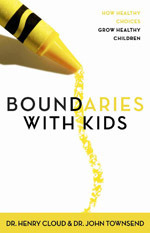 Learn more about how to instill the kind of character in your children that will help them lead balanced, productive, and fulfilling lives in Boundaries with Kids.
Learn more about how to instill the kind of character in your children that will help them lead balanced, productive, and fulfilling lives in Boundaries with Kids.
Image courtesy of Keerati / FreeDigitalPhotos.net
The post Raising Kids With an Eye on the Future appeared first on Boundaries Books.
May 21, 2015
Boundaries Are Not Walls
 Boundaries help distinguish our property so that we can take care of it. We need to keep things that will nurture us inside our fences and keep things that will harm us outside. In short, boundaries help us keep the good in and the bad out. They guard our treasures so that people will not steal them. They keep the pearls inside, and the pigs outside.
Boundaries help distinguish our property so that we can take care of it. We need to keep things that will nurture us inside our fences and keep things that will harm us outside. In short, boundaries help us keep the good in and the bad out. They guard our treasures so that people will not steal them. They keep the pearls inside, and the pigs outside.
Sometimes, we have bad on the inside and good on the outside. In these instances, we need to be able to open up our boundaries to let the good in and the bad out. In other words, our fences need gates in them. And when the good is on the outside, we need to open our gates and “let it in.” Other people have good things to give us, and we need to “open up to them.” Often we will close our boundaries to good things from others, staying in a state of deprivation.
In short, boundaries are not walls. The Bible does not say that we are to be “walled off” from others; in fact, it says that we are to be “one” with them (see John 17:11). We are to be in community with them. But in every community, all members have their own space and property. The important thing is that property lines be permeable enough to allow passing and strong enough to keep out danger.
Often, when people are abused while growing up, they reverse the function of boundaries and keep the bad in and the good out. For example, when Mary was growing up she suffered abuse from her father. As a result, she would close herself off, holding the pain inside; she would not open up to express her hurt and get it out of her soul. She also would not open up to let support from the outside in to heal her. Consequently, when she came in for help, she was carrying a lot of pain, still being abused, and “walled off” from support from the outside. Mary had to reverse the ways her boundaries worked. She needed fences that were strong enough to keep the bad out and gates in those fences to let out the bad already in her soul and let in the good she desperately needed.
Questions to Consider:
Have you confused boundaries as walls that block people from interacting with you? Where do you need to create “gates” in your life that help foster healthy community?
The post Boundaries Are Not Walls appeared first on Boundaries Books.
May 18, 2015
Why Nice People Attract Jerks
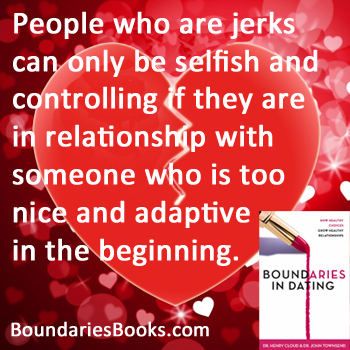 The question that many people wonder is “If I’m nice, then why do I keep attracting such jerks?” They think that something is inherently wrong with them, and sometimes they can begin to get quite hopeless over their chances of finding good friends, someone good to date, or building a great marriage.
The question that many people wonder is “If I’m nice, then why do I keep attracting such jerks?” They think that something is inherently wrong with them, and sometimes they can begin to get quite hopeless over their chances of finding good friends, someone good to date, or building a great marriage.
The key to remember is that the reason why nice people attract jerks is that they are too adaptive in the beginning. If that person had had boundaries, the problem never would have happened. Or if it did, the problem would have been fixed first.
People who are selfish and controlling can only be that way if they are in relationship with someone who is adaptive. If someone stands up to them and is honest about his or her wants and desires, then the controlling person has to learn to share or gets frustrated and goes away. Take these steps to avoid ending up in relationships that attract unhealthy people:
Be honest about your preferences and desires.
Don’t act like you like things other people like just so that you will be accepted.
Being liked for who you are requires that you be that person.
Tell the truth about where you want to go and not go, or what you want to do or not do.
Don’t be afraid to share your desires and wants for fear of conflict. Find out early if you are with someone who can share equally.
Get feedback from honest friends to tell you if you are really being yourself and seeing the relationship realistically.
Remember with each decision that you make you are giving the other person an impression of what you like in life and in a relationship. Be careful—he or she might believe you.
When you give or serve, let it be honest and purposeful.
You are a person, and you cannot go throughout life without pursuing your own wishes, needs, and desires, nor should you. Your needs and desires are going to come out, and you had better find out early in a relationship where the person really stands with the idea of sometimes having to adapt to them. You don’t want to be telling some counselor the following things ten years from now:
She seems to have to have her way.
I am afraid to let my real feelings and desires be known.
We have so much conflict over such little things.
We always spend our money on what he wants.
She doesn’t care about me and what I want.
Why can’t he ever go to the places that I want to go to?
 Issues like these are usually discovered later in a relationship where one person has adapted for a long time, and then tries to make a change. The lesson is to be yourself from the beginning, and then you can find someone who is authentic as well. A relationship like that has mutuality and partnership. It has give and take. It has equality. It has sharing and mutual self-sacrifice for the sake of the other and the relationship.
Issues like these are usually discovered later in a relationship where one person has adapted for a long time, and then tries to make a change. The lesson is to be yourself from the beginning, and then you can find someone who is authentic as well. A relationship like that has mutuality and partnership. It has give and take. It has equality. It has sharing and mutual self-sacrifice for the sake of the other and the relationship.
If you are a real person from the start, a relationship of mutuality has a chance of developing. If you are not, then you might be headed for trouble.
The little things in life are where you can spot the big things. If you are with a self-centered person who cannot give to your desires, you will find out soon enough by being honest and straightforward about simple things, for that is where day-to-day life is lived. You will quickly find out if you are with someone who is able to share, or someone who has to have his or her way all the time. This knowledge will be helpful now and essential for the future.
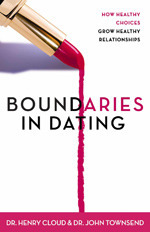
Get more helpful advice to build the best dating relationship and find the love of your life by reading Boundaries in Dating.
Image courtesy of Stuart Miles via FreeDigitalPhotos.net
The post Why Nice People Attract Jerks appeared first on Boundaries Books.
May 14, 2015
How to Move from Stuckness to Success by Dr. John Townsend
 All of us want to be successful in life. We want a career that is fulfilling and that creates a sustainable lifestyle. We want relationships and family connections that are warm and intimate. We want to give back in service to the world in some way. Yet so often, we find ourselves stuck, in getting from where we are, to where we want to be.
All of us want to be successful in life. We want a career that is fulfilling and that creates a sustainable lifestyle. We want relationships and family connections that are warm and intimate. We want to give back in service to the world in some way. Yet so often, we find ourselves stuck, in getting from where we are, to where we want to be.
If you have found yourself stuck instead of successful in some area of life, it is likely that there is some sort of a problem in your being free to make the choices you need to make. That is, you may not be executing the right boundaries to help you move forward. When you set healthy boundaries in the right way, really good things can happen. Here are three tips to help you move from stuck to successful:
1. Determine what you want, vs. what others want from you.
This is a critical boundary to set. Often, we think of what others expect before we know what we really want in life. Yet the Bible tells us to make choices all the time, for example who we worship: “…choose for yourselves this day whom you will serve” (see Joshua 24:15). So get a piece of paper and write what you want to happen: a career goal, a relationship problem solved, a financial dream or a health goal. It does matter what people think, and we do impact others. Take those into consideration. But start with your own goal and desire and work from there.
2. Say no to the “good” and yes to the “right.”
Most of us don’t have major issues saying no to really toxic influences like drugs or crime. We aren’t supposed to do those things in the first place! But it is trickier to say yes to those things that aren’t inherently bad, but take time and energy from what you want. We can’t do everything, so we have to say no to good things to get to the right things. For example, you may need to decline your involvement on a committee because you can’t get to your own goals. Or you may need to tell a friend you can’t talk on the phone as frequently as you would like, because you don’t have the time. These aren’t fun decisions. But they free you up to work on that goal or relationship.
3. Have difficult conversations with people who are operating against you.
There are, unfortunately, people who can be controlling, negative, judgmental or hurtful with you. This is such a power drain, how can you move from stuckness to success when you have their influence deflating your passion? Good boundaries mean having a loving but direct talk with some key people, in which you say, in effect, “I care about you and us, but your behavior makes it difficult for me to be around you. I would like to see some changes in our relationship, otherwise I will need to make some distance, which I don’t want.” Our book How to Have That Difficult Conversation You’ve Been Avoiding will help you with this issue.
Jesus taught us to let our yes be yes, and our no be no (see Matthew 5:37). Growth research, high performance research, and our own experience show that His words are true and that they work. Here’s to your own movement from stuckness to success!
The post How to Move from Stuckness to Success by Dr. John Townsend appeared first on Boundaries Books.



